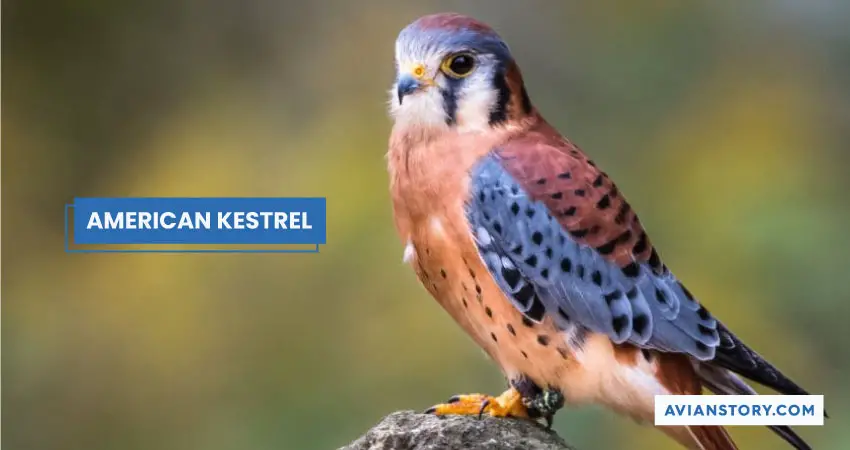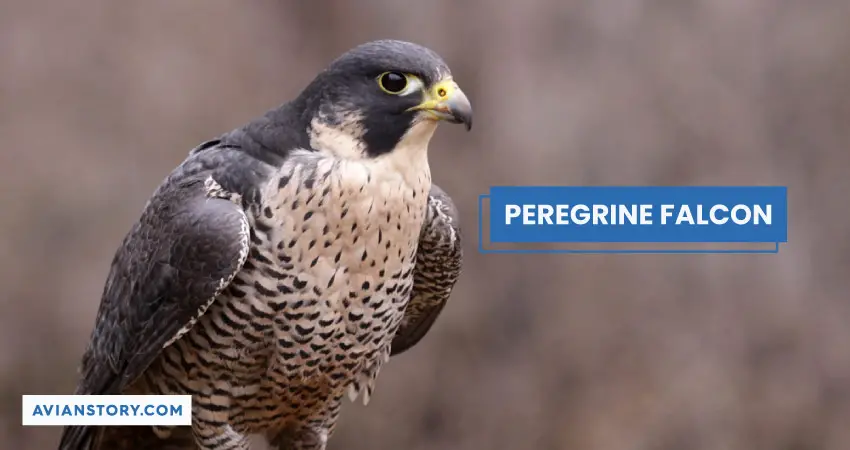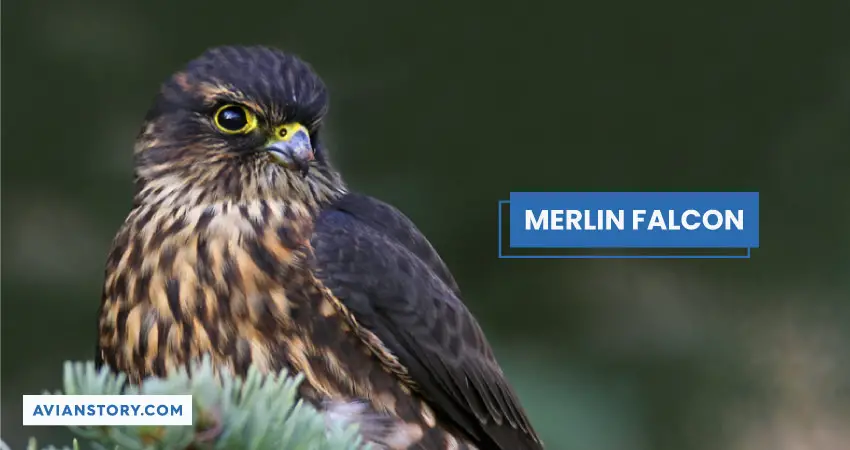Falcons in Wisconsin: Identification, Species Profile, and More!
The Wisconsinite forests, bluffs, and coastlines are home to beautiful raptorial birds, including falcons. American Kestrel, Peregrine Falcon, Merlin, and Gyrfalcon are the 4 species of falcons commonly found in Wisconsin.
These majestic raptors can be found perched on the steep ledges of superstructures, hovering over songbirds, or zooming off with clenched talons.
The Badger State has unique landscape features that support these predatory birds, unlike any other state. We uncovered a lot of information about the falcons in Wisconsin from our latest birding tour. Have a look!
Are There Falcons in Wisconsin?
The lush hills, farmlands, and valleys of Wisconsin are safe habitats for different species of falcons, namely American Kestrel, Gyrfalcon, Peregrine Falcon, and Merlin.
Due to urbanization, many of these diurnal birds now nest on the window sills of high-rise buildings and tower blocks in WI.
Falcons, in general, are blessed with superspeed, which makes it difficult to ID them from a distance. These are the tell-tale features of falcons that will help you recognize these birds in the Badger State —
| Species Name | Appearance | Wingspan | Habitat | Diet | Special Feature |
| American Kestrel | Rusty back and slate-blue wings | 20.1″- 24″ | Tree cavities, nest boxes | Crickets, grasshoppers, dragonflies | It’s the smallest falcon in North America |
| Merlin | Dark brown head and a white throat | 20.9″- 26.8″ | Grasslands, valleys, and seashores | Songbirds, shorebirds, sparrows, and snakes | They hunt for prey using sneak attacks |
| Peregrine Falcon | A dark mustache and blue-gray back | 39.4″- 43.3″ | Coniferous forests and coastal areas | Gulls, geese, waterfowls, loons, and sterlings | The Peregrine falcon is faster than a cheetah |
| Gyrfalcon | It looks like a snowy owl | 48″- 63″ | Tundra, swampy forests, and bluffs | Ptarmigans, hares, seabirds, and lemmings | The biggest falcon in Northern Hemisphere |
Falcons That You Can Find in Wisconsin
American Kestrel – Falco Sparverius

The American Kestrel is the smallest falcon in North America. It stands out with its copper-orange countenance, blue streaks, and white cheeks. Nesting commonly in tree holes, American Kestrels feed on live insects, small birds, and rodents.
Species Profile
Length: 8.7″-12.2″
Weight: 2.8- 5.8 oz.
Wingspan: 20.1″- 24″
Identification
American Kestrels are well-known for their rusty orange visage. The male members have a rusty back, slate-blue wings, and a chestnut brown tail. The females’ wings are reddish-brown in color.
Falco Sparverius has pale blue feathers on its head. Both sexes have dark eyes, black sideburns that look like two vertical lines on the sides of their faces, short unfeathered legs, and a notched beak.
Male Kestrels sport a dark band at the tip of their tails, which is different from the black barring on a female bird. Adult males have orangey breasts with a buffy underside. The females appear a paler color with rufous-brown streaks.
Range
American Kestrels are spotted in Wisconsin during the summer season. In winter, the majority of them migrate to the southern states or Central America. When summer approaches, most return to their northern nesting site, and some may fly to Mexico.
Males return to the breeding ground before females to find nest cavities in early spring. Kestrels are found year-round in the southern region of the USA. It makes this species a permanent part of the wildlife in 35 US states.
Habitat
Falco Sparverius is the only North American falcon that can be found nesting in tree cavities, woodpecker holes, and nest boxes.
Male and female kestrels part ways in winter during their migration to the South. They get together again for the summer breeding season. The male kestrel shows the female a tour of potential nesting locations, which is very often near the old nesting site.
In Wisconsin, American kestrels reside in the farmlands, marshes, lakeside plains, and the big cities where they perch on telephone poles.
Diet
American Kestrels like to eat beetles, butterflies, crickets, dragonflies, grasshoppers, sparrows, and small birds and amphibians. Like the other falcons in the Dairyland, Kestrels hover over their prey and demonstrate a killer hunting stoop.
American kestrels are also ground feeders, which means they forage insects, small reptiles, and invertebrate prey on the ground.
Life Cycle
The mating season for American Kestrels is from late March to early June in Wisconsin. Female ones lay about 3 to 7 eggs which typically hatch in a month. Both male and female kestrels incubate the eggs and feed the chicks. Young kestrels remain with their parents for a few weeks after they fledge.
Cool Facts About the American Kestrel
- American Kestrels are monogamous. In both sedentary and migratory populations, some pairs stay together and use the same nesting site for years.
- Despite being a raptor, the American Kestrel often falls prey to bigger birds, such as Northern Goshawks, Barn Owls, and Red-tailed Hawks, as well as rats, snakes, and fire ants.
- Many people mistake American Kestrels for Mourning Doves. The flight of a Kestrel is made of long glides, whereas Mourning Doves fly with continuous wingbeats.
Peregrine Falcon- Falco Peregrinus

Sporting a gunmetal back, barred white underside, and a yellow beak, the Peregrine Falcon is both the world’s fastest bird and animal. This super-bird makes rare appearances in the bustling cities in Wisconsin when it migrates through the Northern regions of America.
Species Profile
Length: 14.2″- 19.3″
Weight: 18.7-56.4 oz
Wingspan: 39.4″- 43.3″
Identification
The Falco peregrinus has slate-blue, tapered wings, a short tail, and excellent bilateral symmetry. Peregrine falcons are about the same size as crows. They have distinctive yellow eyes and beaks that set them apart from Sparrow Hawks and Prairie falcons.
Peregrine falcons have prominent facial markings— a black mustache and a cap. Both sexes have similar features and plumage. The female bird grows about 30% larger than the male.
Males have a sleek physique and light-gray underside, barring the heavy marking typically found on the underparts of female falcons.
Range
Peregrine falcons breed on Lake Superior in the summer and stay year-round in the Great Lakes. Resident populations of Peregrine falcons are found near Lake Michigan, as well as the Mississippi River bordering the western part of Wisconsin.
Migratory Peregrine falcons travel through WI for a brief period in winter. They spend the wintry months in the South-Eastern US and summer in Northern Canada, moving around the continent in between.
Habitat
Peregrine falcons have grown accustomed to human habitation and use bridges, quarries, and high-rise buildings as nesting sites. The Apostle Islands National Lakeshore, a national park in Wisconsin, is a crucial habitat for migratory Peregrine falcons.
These raptors take a liking to open spaces and thrive best in coastal areas. You may enjoy a rare sight of the peregrine falcon in Northern Wisconsin, where pine plantations are abundant.
Diet
Peregrine falcons use their incredible speed for hunting down doves, ducks, and a wide range of shorebirds. They are infamous for taking prey as huge as gulls, geese, and loons.
Because of their predatory strength, Peregrine falcons never have to forage. They almost exclusively eat smaller birds, such as Waterfowl and Starlings. In the city, these carnivorous birds have their eyes set on pigeons and rodents and will seldom eat insects.
Life Cycle
Most Peregrine falcons can fly after 45 days of hatching and hunt by themselves when they are two months old. Like kestrels, Peregrine falcons mate for life and participate equally in raising their hatchlings.
Among all the species of falcons, Peregrine falcons have an impressive mortality rate. In the wild, they can live up to approximately 19 years.
Interesting Facts About the Peregrine Falcon
- Peregrine falcons can dive at a speed of 240 mph— three times as fast as cheetahs.
- The maximum speed recorded by a Peregrine falcon is 388 mph, which is faster than a formula one race car.
- Peregrine falcons can survive in the tundra, the tropics, and deserts.
- The flight of Peregrine falcons is so powerful that it can break apart the human spinal cord in a collision.
Merlin – Falco Columbarius

Unlike other members of the genus Falco, these small, fast-flying falcons pursue their prey in repeated wingbeats. They have slate-blue wings and are typically found in the moorlands in Wisconsin.
Species Profile
Length: 9.4″- 11.8″
Weight: 5.6-8.5 oz
Wingspan: 20.9″- 26.8″
Identification
Merlins are one of the smallest birds of the falcon family, growing about the same size as an American Kestrel or a Mourning Dove. They sport dark, bluish-gray wings and back.
Adult Merlins have a buffy underside which is streaked with fuzzy white and brown feathers. They feature a dark brown head and yellow legs. Merlins have two white horizontal stripes on their face that give the appearance of eyebrows.
Merlins are easy to ID because of their stocky bodies and white, unmarked throat. The upper parts of the female Merlin are dark-brown, their tails banded in chrome yellow bars with a snowy tip.
Range
Falco columbarius, or Merlins, can be found year-round in the Northern Hemisphere. Wisconsin lies at the southernmost area of their breeding range. Merlins winter throughout Northern America, Central America, and several states in the southeast.
They migrate to the Northern US and Canada in Spring, where they breed in the open forests and grasslands.
Habitat
From grasslands to marshlands, Merlins have a wide range of habitable places.
They favor open countries such as riverside valleys, grasslands, shrublands, and the vast farms in Northern Wisconsin.
Merlins are found along the seashores, steppes, sand dunes, and deserts. In the breeding season, they like to nest in coniferous forests.
Diet
Merlins prefer forest openings and coastal areas where they can prey on songbirds, shorebirds, and insects. They feed on small to medium-sized songbirds, small mammals, snakes, and lizards.
Falco columbarius are fierce aerial foragers. In the wild, they hunt for sparrows, finches, larks, and grouse. In Wisconsin and other Northern states, Merlins have an appetite for dragonflies. But birds make up about 80% of their diet.
Life Cycle
Merlins use the same nesting range for years. They lay eggs in early April in the Southern ranges and in late May in the Northern ranges at two-day intervals. The incubation period of Merlins is about a month.
Young Merlins learn to fly as early as 30 days after hatching. Six weeks after leaving the nest, the young become adept at hunting and can catch small birds.
Interesting Facts About the Merlin
- In the medieval era, noblewomen used Merlins for hunting Skylarks.
- Merlins were once called “pigeon hawks” in North America.
- They sometimes chase automobiles and trains.
Gyrfalcon- Falco Rusticolus
With an enormous wingspan of 60 inches, Gyrfalcons are the largest raptors in the falcon family. They prefer colder temperatures of the arctic and are seen in Wisconsin for a short time in winter. They look like snowy owls with teardrop markings below the eyes.
Species Profile
Length: 19″ -25.5″
Weight: 28.5- 74 oz
Wingspan: 43″- 63″
Identification
The gyrfalcon has gray-white plumage, spotted wings, and a white underside typical of a snowy owl. Its size and color make the species stand out from other falcons. Gyrfalcons show white, brown, and black coloring. Their white underparts have small brown dots, and their eyes have a tint of yellow.
In the High Arctic, they can appear from chalky white to an alabaster color. The tail pattern on Falco rusticolus shows distinctive black and white bands. And, the white-morph gyrfalcon’s tail is white and shaped like a fan.
Range
Gyrfalcons are commonly seen at the remote cliffs in the US, Canada, Alaska, and the Eurosiberian region. They are rare visitors in the northern United States, where they remain from December to January for wintering.
Like Prairie falcons, the gyrfalcons in Wisconsin are few and far between. Their declining population makes them a rare sight at Cliffwood Bluff and Wisconsin’s conifer forests.
Habitat
These raptors inhabit the chilly barren uplands, treeless plains (tundra), and swampy coniferous forests (taiga). You may find them flying swiftly above the tree line and near bluffs and mountain ranges.
Gyrfalcons like to perch on the rock-strewn ground. During winters in Wisconsin, the biggest falcons in the world prefer the cozy farmlands and grassy territories.
Diet
Gyrfalcons prey on medium seabirds, raptors, and mammals. Their diet consists mostly of ptarmigans, sage-grouse, gulls, ducks, pheasants, and jaegers.
Their tremendous size allows them to feed on other carnivorous birds as large as owls, hawks, and ravens. Gyrfalcons prey on squirrels, lemmings, hares, and numerous birds when they winter in Northern Wisconsin.
Life Cycle
Gyrfalcons can live for more than a decade, approximately 13 years, in the wild. They can live up to 19 years like a Peregrine falcon when raised in captivity.
These fierce raptors have a long incubation period that can last up to 35 days. Gyrfalcons typically nest in the tree nests of Golden Eagles and common ravens. Or, they may nest on cliff ledges that are protected by an overhang.
Cool Facts About the Gyrfalcon
- Gyrfalcons enjoy bathing in icy-cold water.
- They can fly in extremely high altitudes like a golden eagle.
- The male gyrfalcon is known as a gyrkin in falconry.
Rounding Up
Peregrine falcons, American Kestrels, and Merlins are seen year-round in Wisconsin, with the exception of the majestic Gyrfalcon that visits every winter.
Now you know where to find falcons in Wisconsin and how to ID these raptors! You can expect these 4 species in the Badger State in different locations year-round.
Falcons Found in Nearby States of Wisconsin:
